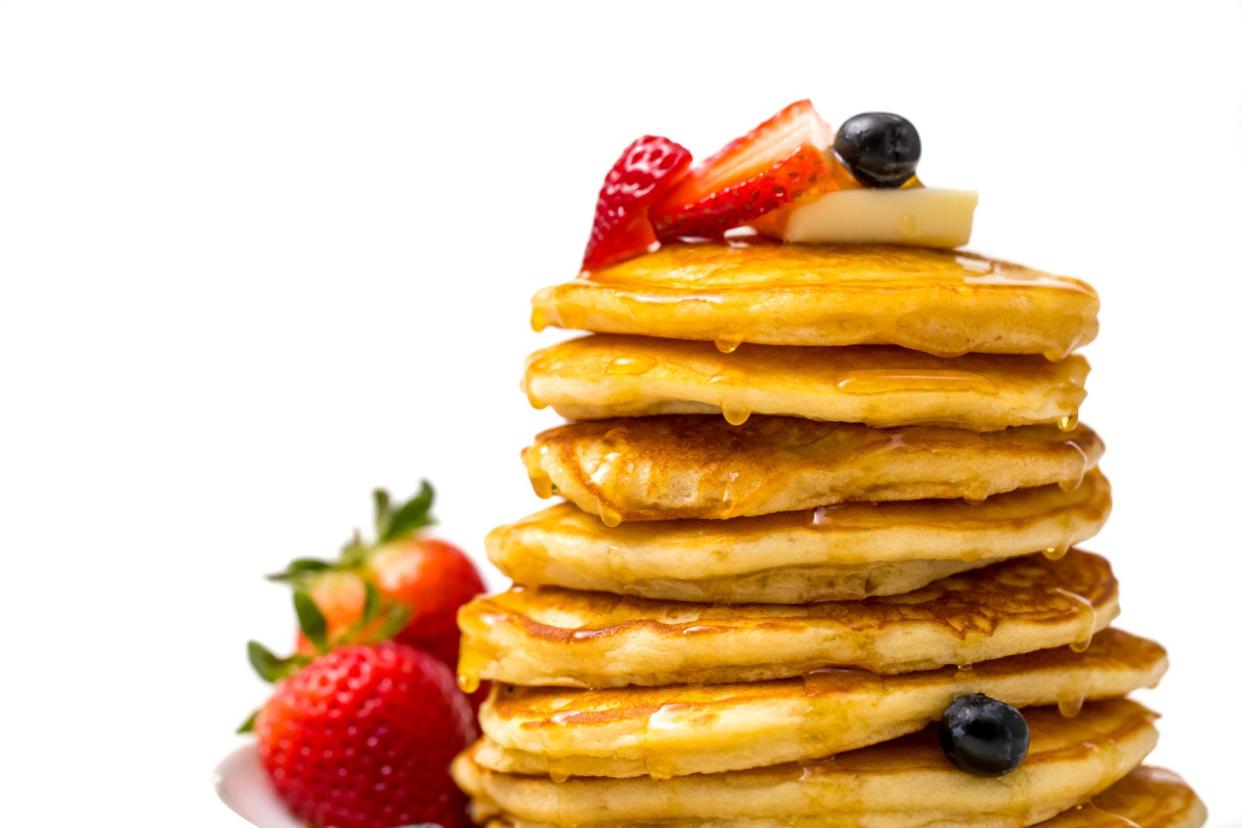The science behind a stack of fluffy pancakes

If you love pancakes, you are not alone. A poll found that 93% of people like pancakes, with 5% saying they are not fond of them and 2% truly hating them.
It’s an odd thing to hate, but that’s not the point of this article. Before we get to the remarkable science of the pancake, a little history.
Pancakes have been around a very long time. When a 5,300-year-old human was found in ice, they found pancakes in his stomach. (That’s a little creepy.) However, pancakes are far older than that. The first written reference to pancakes dates back to the year 600 B.C.
Since that time, the basic idea and science of pancakes has not changed all that much. More or less, they were made with the same types of ingredients that we have now. Those ingredients are just far easier to come by.
Magical ingredients
Flour is the main ingredient in any pancake recipe — and for good reason.
Flour contains two proteins that, when combined with water, string together to form a sticky substance called gluten. Without this sticky substance, the consistency of pancakes would be very hard to come by. However, pancakes of only gluten would not be pancakes at all.
In order to get a fluffy pancake, we need to have gas (carbon dioxide) bubble up through the gluten just as the mixture is heated. This reaction requires an acid and a base. Almost all pancake recipes use baking soda (sodium bicarbonate) for the base. Many pancake recipes use buttermilk for the acid.
When the acid and base are combined, carbon dioxide gas is formed and these bubbles rise through the batter. When cooked, these bubbles make the pancake fluffy.
Sometimes buttermilk is not available, and people use regular milk instead. However, regular milk is not an acid, so it will not react with the base to form gas bubbles. Therefore, when regular milk is used, the recipe will call for baking powder.
Baking powder contains baking soda (a base), cream of tartar (an acid), and cornstarch. The cornstarch is only used to keep the acid and base separated until a liquid is added.
There is just one more important note about fluffiness. If you stir your pancake batter too much, the gas bubbles that your acid and base just produced will be released. Over stirring causes tough, rubbery pancakes. You should barely stir your pancake batter.
Maillard reaction
Now that chemistry has given you the perfect pancake batter, you need to quickly cook the pancakes before all that gas escapes. This is where a very complex set of chemical reactions occurs between the amino acids (from the milk and eggs) and the carbon and oxygen in the sugar.
The reaction between the amino acids, carbon and oxygen creates the flavors and odors our brains crave. It also is responsible for the golden-brown color and just slightly crispy texture of the outside of our pancake.
The Maillard reaction completely changes the flavor of our batter. This chemical reaction is also responsible for many other flavors we love including caramel, bread crust, chocolate, coffee, maple syrup and cooked meat.
Pancake facts
If that was too much science, let’s end with some pancake facts:
The largest pancake ever made was 49 feet wide and weighed 6,614 pounds.
The most expensive pancake can be found in England at a cost of $200. It has Madagascar vanilla pods and gold leaf in the batter.
Mrs. Butterworth’s first name is Joy.
February 21 is National Pancake Day.
The highest pancake toss from a pan was 31 feet, 1 inch.
An average pancake costs about 5 cents in ingredients. Eat up!
Why learn about pancakes today? Mr. Szydlowski’s Jefferson Middle School class will be cooking pancakes while reading this article and learning about these delicious chemical reactions today. Cook your own pancakes and learn with us!
Mike Szydlowski is a science teacher and zoo facilitator at Jefferson STEAM School.
TIME FOR A POP QUIZ
What makes a pancake fluffy?
What does pancake batter need in order for gas bubbles to form?
Buttermilk provides the acid in pancake batter. What would happen if the same recipe was used but with regular milk instead?
What is a Maillard reaction?
If you eat two pancakes a week for a year, how much will the ingredients cost in a year?
LAST WEEK'S POP QUIZ ANSWERS
Why were the seeds brought over from England not very successful?
The soil and climate in the new location was very different than their homeland.
What is an epidemic?
An epidemic is an outbreak of an illness or disease that affects many people.
Why were the Native Americans so much more weakened by disease than the Europeans?
The Native Americans were introduced to germs that their civilizations were not used to nor had resistance to.
How might things have been different if the epidemics did not hit the Native Americans?
If the Native Americans were not weakened by the epidemics, the different tribes may have banded together to stop the colonization by the settlers.
What is one similarity between the pilgrims' celebration and our Thanksgiving?
Both celebrations are meant to give thanks for what you have.
This article originally appeared on Columbia Daily Tribune: The science behind a stack of fluffy pancakes

